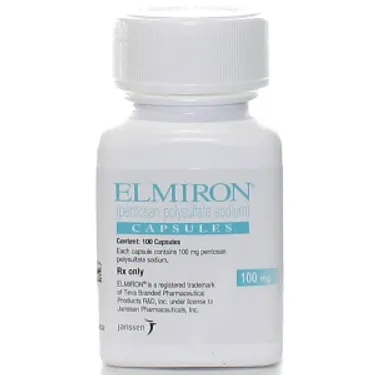Elmiron and Vision Loss
Elmiron® (pentosan polysulfate sodium) is manufactured by Janssen Pharmaceuticals, a Johnson & Johnson division.
The U.S. Food and Drug Administration (FDA) approved Elmiron® for sale in 1996 to treat pain associated with interstitial cystitis (IC) or painful bladder syndrome (PBS) and osteoarthritis.
ELMIRON® is supplied in white opaque hard gelatin capsules imprinted “BNP7600” containing 100 mg pentosan polysulfate sodium. It is supplied in bottles of 100 capsules.

Elmiron® Drug Trials
Drug testing has multiple objectives, from quantifying a drug’s effectiveness to discovering and publishing potential side effects.
For example, in one trial maximum pain relief took at least 3 to 6 months in 40% to 60% of patients.
Other tests resulted in significant IC pain improvement compared to the placebo (28% of treated subjects versus 13% of placebo controls). However, the overall improvement of reported symptoms was not dramatic.
In addition to documented effectiveness data, Janssen was also alerted to potentially dangerous side effects of vision loss or blindness. Numerous participants reported vision problems after starting Elmiron®.
The most common side effects are relatively mild. They include hair loss, diarrhea, nausea, blood in the stool, headache, rash, upset stomach, abnormal liver function tests, dizziness and bruising.
Unfortunately, other side effects – including vision damage – were not included on the label.
Drug companies have options in how they handle reported side effects and negative test results. They can withhold the drug and work to improve it. And, they can follow-up with additional trials.
They can also release the drug, documenting their findings of potential side effects for the public benefit – such as with label warnings.
Instead, Jannsen choose to release Elmiron® without labeling the potential vision-related side effects. Johnson & Johnson has earned billions of dollars in profits from drug sales.
The public deserves to know that FDA-approved drugs are both effective and safe. The manufacturer knew of the link between Elmiron® and eye damage when the drug went to market in 1996 and has failed to acknowledge the severe risks until 2020.
As late as June 2020, the Elmiron® label stated, “Warnings: None.”
Finally, on June 16, 2020, the FDA announced Elmiron® drug safety-related labeling changes. The FDA added this WARNING:
“Pigmentary changes in the retina, reported in the literature as pigmentary maculopathy, have been identified with long-term use of ELMIRON® (see ADVERSE REACTIONS). Although most of these cases occurred after 3 years of use or longer, cases have been seen with a shorter duration of use. While the etiology is unclear, cumulative dose appears to be a risk factor. Visual symptoms in the reported cases included difficulty reading, slow adjustment to low or reduced light environments, and blurred vision.”
The June 2020 FDA announcement also included a leaflet for pharmacists to give to Elmiron® patients. It states that the “most important information” to know about Elmiron® is that reported symptoms include: difficulty reading, slow adjustment to low or reduced light environments, and blurred vision.
Maculopathy is a leading cause of blindness. Pigmentary maculopathy has been linked to Elmiron® use by leading medical doctors and institutions.
Harvard Medicine, Emory Eye Clinic, and Kaiser – all international leaders in eye diseases – have published medical results confirming the link between Elmiron® and eye damage.
The Journal of Ophthalmology published a study documenting a direct link between Elmiron® and vision loss.
A growing number of urologists and IC specialists are advising against taking Elmiron®. For example, the Advanced Urology medical group in Georgia states on their website: “Elmiron has recent reports of permanent eye damage, and we do not advocate its use at this time.”
However, many doctors may not yet know about the link between Elmiron® and eye damage. The FDA added the new ADVERSE EFFECTS section to the Elmiron® labeling in July 2020, but the drug has been prescribed since 1996.
If you have been taking Elmiron® long-term and subsequently experienced vision problems, contact us today.
If you want to discuss this with your doctor, referencing the studies above may be helpful. Contact us, and we can provide the research in a concise and convenient form for your doctor.
The medical case studies of patients suffering damage reveal that even if the patient stops taking Elmiron®, the damage may remain. In other words, the damage may be permanent.
In most cases, eye damage is found after long-term use (3+ years). However, it has also occurred with shorter-term use. Contact us today by phone or fill out our simple form. Do not delay.
- Change in eye color
- Blurred vision
- Difficulty reading
- Poor light to dark adaptation
- Dark spots in vision
- Straight lines appear curved
- Muted, less vivid colors


Blurred Vision


Poor Light to Dark Adaptation
- Primarily women
- Ages 30 and up
- Chronic long-term users
- Interstitial Cystitis / Painful Bladder Syndrome
The most common symptoms, based on consolidated clinical observations, are:
- Blurred vision (48.6 percent)
- Poor or prolonged light to dark adaptation (48.6 percent)
- Metamorphopsia – straight lines appear curved (11.4 percent)
If you have taken Elmiron® long-term and are experiencing vision problems, it is important that you understand the medical risks and how to protect yourself – both healthwise and legally.
Find out if you qualify for a possible settlement.
Contact us today by phone or find out if you qualify here. Our online form should take less than ten minutes.
In general, if you have taken Elmiron for at least 1 year and have been diagnosed with pigmentation maculopathy, macular degeneration,
pigmentation maculitis, or retinal maculopathy you may qualify.
If you have taken Elmiron for 4 years or more and experience blurred vision, central vision loss, or poor light to dark adaption, you also may qualify.
If you have taken Elmiron for 3-4 years and have been diagnosed with wet macular degeneration or age-related macular degeneration, our attorneys will review your case.
If you are unsure if you meet these criteria, call or check here.
Accept
At least 1 year Elmiron use and diagnosis of a qualifying injury
pigmentation maculopathy
pigmentation macular degeneration
pigmentation maculitis
retinal maculopathy
dry macular degeneration
4+ years Elmiron use and qualifying symptoms during use
blurred vision
central vision loss
poor light to dark adaption
Attorney Review
3-4 years use and diagnosed with
wet macular degeneration diagnosis
age-related macular degeneration diagnosis
Decline
Less than 3 years use + no formal diagnosis
client deceased, incarcerated, or out of the country
Tags: blindness, painful bladder syndrome, interstitial cystitis, Elmiron, pentosan polysulfate sodium, retinal maculopathy, retinal pigmented epithelium, Janssen Pharmaceutical, Janssen-Ortho, Janssen Global Services, Johnson & Johnson
